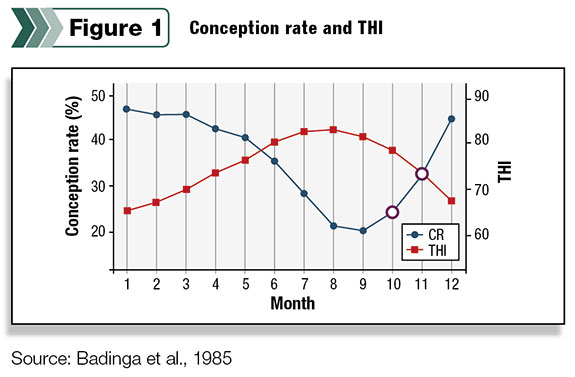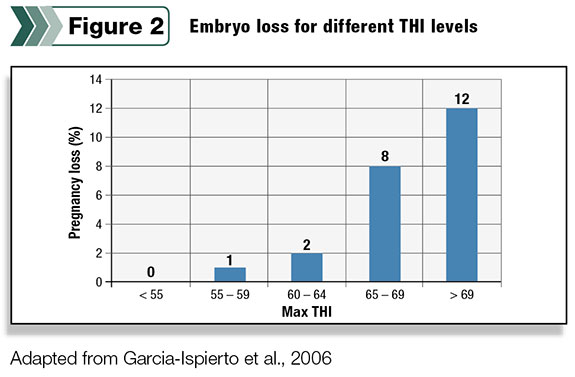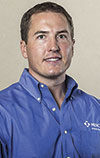When summer winds down and temperatures begin to improve, dairy producers can tend to forget about the lag in fertility experienced as a result of heat stress.

Temperature-humidity index (THI), used to evaluate when cows become heat stressed, and conception rates have an inverse relationship, as illustrated in Figure 1 illustrating the well-known fact that heat stress drastically reduces fertility.
To that point, in the two months following the end of summer (in October and November in this Florida study), fertility still has not reached levels seen during the cooler months of the year.
In addition, the fact that milk production usually bounces back to normal levels much earlier sometimes can be misleading by insinuating that the cows are no longer under heat stress.
Higher production escalates heat-stress challenges
Heat stress is a growing management challenge for a few reasons. First, with the continued increase in milk production per cow, sensitivity of the dairy cow to heat stress has increased.
Second, higher milk production associated with an increase in dry matter intake enhances metabolic heat production, which aggravates thermoregulatory competence of lactating dairy cattle.
Since cows are bred for increased milk production, genetic improvement of dairy cattle escalates the challenges of heat stress at the expense of reproduction.
Research results show that milk production declines during summer months, and fertility declines even more. It is common to experience a 10 to 30 percent reduction in milk production depending on the severity of heat stress and amount of proper cow comfort (cooling).
It’s also common for cows to be 30 to 70 percent less fertile during heat stress, so as cows continue to produce more milk, fertility will be a year-round challenge and even more so during the heat-stress season.
The science of summer fertility lag
So why does fertility reduction last beyond the heat-stress season? Heat stress negatively affects cows and bulls reproductively in similar ways.
In bulls, sperm are damaged by heat stress, and it takes 40 to 50 days to complete the spermatogenic cycle leading to the production and ejaculation of new sperm.
A comparable time lag for recovery in the female ovary and egg accounts for a considerable portion of the delay in restoration of fertility seen well into the fall.
Embryo survival also is a factor of heat stress. Prior to ovulation, eggs (still in the growing follicle) obtained from dairy cows during the summer heat-stress period have a reduced ability to become fertilized and make a viable embryo.
When superovulated donor heifers were exposed to heat stress for only 16 hours beginning at the onset of estrus, the number of normal embryos recovered were reduced on day seven after estrus.
This illustrates that a brief heat stress can still affect egg (oocyte) competence within the preovulatory follicle.
In addition, embryos collected from superovulated donor cows in summer months were less able to develop in culture than embryos collected from superovulated cows during fall, winter and spring months.
New growing embryos (2 to 3 days of life) also are more susceptible to heat stress than other stages of life.
The tipping point of heat stress

Figure 2 on depicts the early embryo loss that occurs during heat stress in lactating dairy cows.
This reinforces that heat stress can dramatically affect fertility, but more important is the THI tipping point at which embryo losses increase.
Heat stress dramatically increases early embryo loss at a THI of more than 65.
However, the industry recommends beginning cooling animals at a THI of 68 to 70, though this recommendation comes from studies that only evaluated milk production.
The figure suggests that reproduction is negatively affected during summer heat stress at temperatures cooler than expected and may warrant extending cooling strategies beyond 68 THI.
This variance from 68 to 65 THI signals the need for additional research to better define the ideal time to implement cooling strategies taking into account both milk production and reproduction.
Tips for managing summer fertility lag
With the extreme reduction in fertility, which lags well into the fall months, and the effects on the early growing embryo, which can occur at temperatures cooler than expected, producers should continue to focus on keeping cows cool until the THI is under the recommended limit of 68.
This will help reproduction rebound sooner and reduce the costly lag in fertility. Don’t be too quick to stop aggressively managing your cows to combat summer heat. Below are several tips to follow to best manage the after-effects of heat stress on your herd.
1. Provide proper cooling. Shades, soakers and fans should be located in places that are extremely hot and where cows spend most of their time. The holding pen is a hot box; then go to your fresh cows and then the rest of the herd. Don’t forget your dry cows.
2. Cool longer. Remember to use cooling systems until THI has dropped below 68. Don’t turn them off too early or stop maintenance too soon because fall is approaching.
3. Bulls experience heat stress too. Heat stress decreases sperm concentration, lowers sperm motility and increases percentage of morphologically abnormal sperm in an ejaculate.
After a period of heat stress, semen quality does not return to normal for approximately two months because of the length of the spermatic cycle, adding to the carryover effect of heat stress on reproduction.
However, the use of frozen-thawed conventional semen and A.I. bypasses effects of heat stress on male fertility.
For example, many dairy producers in the U.S. use artificial insemination (A.I.) for a set number of breedings (i.e., three A.I. breedings) and then move the cow to a corral with natural breeding; however, it may be advantageous to continue to A.I. for several more breedings to bypass the deleterious effects described above during and for a two-month period after heat stress.
4. Provide adequate water. Water consumption increases 1.2 to two times during heat-stress conditions. Since milk is 90 percent water, how much cows drink is vital to milk production and maintained thermo-homeostasis.
5. Work when it’s coolest. Vet checks, pen moves and lock-up should be completed early in the morning when cows and temperatures are the coolest.
A cow’s body temperature is warmest between 6 PM and midnight, so reducing activity during this time also can reduce heat stress.
6. Utilize a robust timed-A.I. (TAI) program. A TAI protocol can help improve fertility during summer months. Research has shown that a TAI protocol increased pregnancy from 16.5 percent in the control group to 27 percent in the TAI protocol, while decreasing days open, interval from calving to first breeding and services per conception.
7. Assess heat stress on your dairy. There are tools and simple strategies to evaluate if your cows are heat stressed. Use new apps, temperature devices, measure respiration rates, evaluate lying times, etc., to evaluate the severity of heat stress and where your heat stress occurs.
Managing heat stress at the end of summer is similar to taking a seven-day antibiotic pack when you’re sick. You may start feeling better after day four or five, but it’s important to take the medication for all seven days to be completely cured.
In much the same way, cows will be more comfortable at 40 to 50 degrees, 20 to 30 degrees cooler than our comfort zone.
So when you’re feeling comfortable, it’s not a sign that your cows are comfortable too. Keep your heat-stress management strategies in place until fall temperatures reach at least 68 to 70 THI to avoid the summer fertility lag. PD
Todd Bilby has a Ph.D. in reproductive physiology from the University of Florida and is a dairy technical services manager for Merck Animal Health in Ft. Worth, Texas. He specializes in dairy reproduction, cow comfort and transition cow management.

-
Todd Bilby
- Dairy Technical Services Manager
- Merck Animal Health
- Email Todd Bilby






